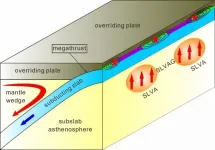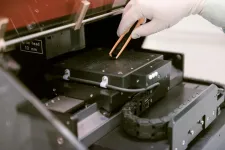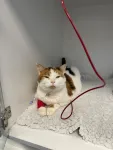(Press-News.org) DURHAM, N.C. - Engineers at Duke University have developed the world's first fully recyclable printed electronics. By demonstrating a crucial and relatively complex computer component -- the transistor -- created with three carbon-based inks, the researchers hope to inspire a new generation of recyclable electronics to help fight the growing global epidemic of electronic waste.
The work appears online April 26 in the journal Nature Electronics.
"Silicon-based computer components are probably never going away, and we don't expect easily recyclable electronics like ours to replace the technology and devices that are already widely used," said Aaron Franklin, the Addy Professor of Electrical and Computer Engineering at Duke. "But we hope that by creating new, fully recyclable, easily printed electronics and showing what they can do, that they might become widely used in future applications."
As people worldwide adopt more electronics into their lives, there's an ever-growing pile of discarded devices that either don't work anymore or have been cast away in favor of a newer model. According to a United Nations estimate, less than a quarter of the millions of pounds of electronics thrown away each year is recycled. And the problem is only going to get worse as the world upgrades to 5G devices and the Internet of Things (IoT) continues to expand.
Part of the problem is that electronic devices are difficult to recycle. Large plants employ hundreds of workers who hack at bulky devices. But while scraps of copper, aluminum and steel can be recycled, the silicon chips at the heart of the devices cannot.
In the new study, Franklin and his laboratory demonstrate a completely recyclable, fully functional transistor made out of three carbon-based inks that can be easily printed onto paper or other flexible, environmentally friendly surfaces. Carbon nanotubes and graphene inks are used for the semiconductors and conductors, respectively. While these materials are not new to the world of printed electronics, Franklin says, the path to recyclability was opened with the development of a wood-derived insulating dielectric ink called nanocellulose.
"Nanocellulose is biodegradable and has been used in applications like packaging for years," said Franklin. "And while people have long known about its potential applications as an insulator in electronics, nobody has figured out how to use it in a printable ink before. That's one of the keys to making these fully recyclable devices functional."
The researchers developed a method for suspending crystals of nanocellulose that were extracted from wood fibers that -- with the sprinkling of a little table salt -- yields an ink that performs admirably as an insulator in their printed transistors. Using the three inks in an aerosol jet printer at room temperature, the team shows that their all-carbon transistors perform well enough for use in a wide variety of applications, even six months after the initial printing.
The team then demonstrates just how recyclable their design is. By submerging their devices in a series of baths, gently vibrating them with sound waves and centrifuging the resulting solution, the carbon nanotubes and graphene are sequentially recovered with an average yield of nearly 100%. Both materials can then be reused in the same printing process while losing very little of their performance viability. And because the nanocellulose is made from wood, it can simply be recycled along with the paper it was printed on.
Compared to a resistor or capacitor, a transistor is a relatively complex computer component used in devices such as power control or logic circuits and various sensors. Franklin explains that, by demonstrating a fully recyclable, multifunctional printed transistor first, he hopes to make a first step toward the technology being commercially pursued for simple devices. For example, Franklin says he could imagine the technology being used in a large building needing thousands of simple environmental sensors to monitor its energy use or customized biosensing patches for tracking medical conditions.
"Recyclable electronics like this aren't going to go out and replace an entire half-trillion-dollar industry by any means, and we're certainly nowhere near printing recyclable computer processors," said Franklin. "But demonstrating these types of new materials and their functionality is hopefully a stepping stone in the right direction for a new type of electronics lifecycle."
INFORMATION:
This work was supported by the Department of Defense Congressionally Directed Medical Research Program (W81XWH-17-2-0045), the National Institutes of Health (1R01HL146849) and the Air Force Office of Scientific Research (FA9550-18-1-0222).
CITATION: "Printable and Recyclable Carbon Electronics Using Crystalline Nanocellulose," Nicholas X. Williams, George Bullard, Nathaniel Brooke, Michael J Therien, Aaron D. Franklin. Nature Electronics, April 26, 2021. DOI: 10.1038/s41928-021-00574-0
A new way to identify tumours that could be sensitive to particular immunotherapies has been developed using data from thousands of NHS cancer patient samples sequenced through the 100,000 Genomes Project. The MMRDetect clinical algorithm makes it possible to identify tumours that have 'mismatch repair deficiencies' and then improve the personalisation of cancer therapies to exploit those weaknesses.
The study, led by researchers from the University of Cambridge's Department of Medical Genetics and MRC Cancer Unit, identified nine DNA repair genes that are critical guardians of the human genome from damage caused by oxygen and water, as well as errors during cell division.
The team used ...
Australian scientists have unlocked another mystery of the class of microorganisms believed to be among Earth's oldest of life forms, throwing new light on the study of cell division and the evolution of life.
In a newly published paper in Nature Microbiology a research team from the iThree Institute at the University of Technology Sydney describes the cell division process used by the microorganism Haloferax volcanii from the archaea realm of single-celled life, which is distinct from bacteria.
Archaea make up the third major grouping, or domain, of life on the planet, alongside eukaryotes (including all plants and animals) and bacteria, but were only recognised ...
Earthquakes and volcanoes in subduction zones may cause great human catastrophe. Previous studies on subduction zone structure and causal mechanisms of giant megathrust earthquakes (M ≥ 9.0) have mainly focused on aspects like subducting plates and plate interfaces.
In contrast, the oceanic asthenosphere structure beneath the subducting slab (at depths of 100-250 km) and its influence on the nucleation of giant megathrust earthquakes have not been well studied.
Recently, Dr. FAN Jianke from the Institute of Oceanology of the Chinese Academy of Sciences (IOCAS) and Prof. ZHAO Dapeng from Tohoku University ...
Weight loss surgery is more effective than dieting to reduce brain pressure that can cause blindness in patients with a neurological condition, finds a study led by the University of Birmingham and University Hospitals Birmingham NHS Foundation Trust (UHB).
Idiopathic Intracranial Hypertension (IIH) is a debilitating condition that raises pressure in the brain and can lead to chronic headaches and even permanent sight loss. The illness, which often leaves patients with a reduced quality of life, predominately affects women aged 25 to 36 and weight gain is a major risk factor of developing IIH and relapses of the disease.
Weight ...
Sponges: They are considered to be one of the most primitive forms of animal life, because they have neither locomotion organs nor a nervous system. A team around deep-sea scientist Antje Boetius has now discovered that sponges leave trails on the sea floor in the Arctic deep sea. They conclude that the animals might move actively - even if only a few centimetres per year. They are now publishing these unique findings in the journal Current Biology.
The surprise was great when researchers looked at high-resolution images of the sea floor of the Arctic deep sea in detail: Path-like tracks across the sediments ended where sponges were located. These trails were observed to run in all directions, ...
Monday, 26 April 2021: A national study of 20,000 patients conducted by RCSI University of Medicine and Health Sciences and the HSE Health Protection Surveillance Centre (HPSC) has identified the underlying conditions that are associated with more severe outcomes from COVID-19 in an Irish setting.
The research, which has been published in The Lancet Regional Health - Europe, will help inform national public health policies and assist in future treatment and prevention strategies for people at most risk from the virus.
The study, which took place during the first wave of the pandemic between March and July 2020, is the first national surveillance study in Ireland that captures data from both hospital ...
MINNEAPOLIS/ST.PAUL (04/26/2021) -- A new study by five doctoral students in neuroscience at the University of Minnesota Medical School calls attention to a lack of regulation and unknown long-term health effects of tear gas. Based on their research, the group recommends changing the protocols around the use of tear gas as a crowd control measure at both the local and national level.
"Following the murder of George Floyd and the protests in our city, we felt compelled to dig into the police force used during those protests. We are trained to look at data and ...
A NUST MISIS professor was part of an international research team that has found evidence for the existence of the Zeeman spin-orbit coupling in antiferromagnetic conductors. This work may pave the way for the next generation of electronics. The study was published in npj Quantum Materials.
The electron possesses two fundamental properties: charge and spin. Conventional electronic devices use only the charge of electron for information processing. In recent years, an enormous research effort has been focused on building fundamentally new electronic devices (often called "spintronic devices") that would specifically exploit spin properties in addition to charge degrees of freedom. Transfer from conventional electronics to spintronics technology opens the possibilities to construct devices ...
BROOKLYN, New York, Thursday, April 22, 2021 - Rising sea levels and more powerful cyclonic storms, phenomena driven by the warming of oceans due to climate change, puts at immediate or potential risk an estimated 680 million people living in low-lying coastal zones (a number projected to reach more than one billion by 2050). In nations like Bangladesh these populations are already moving to escape sea-level rise.
In a new study, "Modeling human migration under environmental change: a case study of the effect of sea level rise in Bangladesh," researchers led by Maurizio Porfiri, an engineer at ...
Blood transfusions are a common procedure in medical practice in which donated blood is used to replace blood lost to injury or surgery or to treat serious medical conditions. The procedure is not performed as routinely in the treatment of pet cats - but, as in people, can be lifesaving. The availability of donors has been a limitation in primary care veterinary practice, but with the growth of blood banks providing greater access to feline blood, the procedure is likely to become more commonplace.
To address the need for authoritative guidance, not only on best practice but also some important considerations beyond the clinical procedure itself, the International Society of Feline Medicine (ISFM) has today published consensus guidelines in the Journal ...


